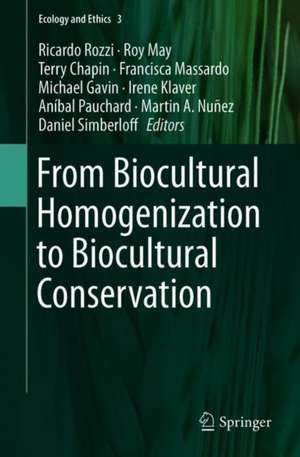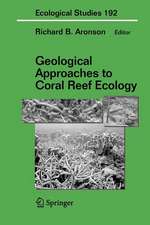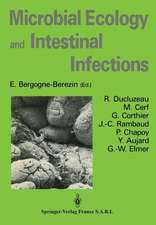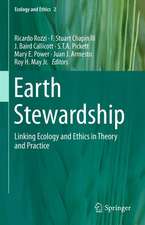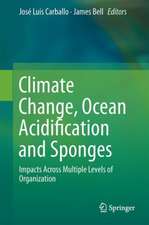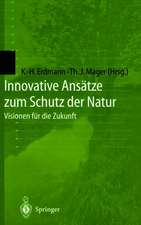From Biocultural Homogenization to Biocultural Conservation: Ecology and Ethics, cartea 3
Editat de Ricardo Rozzi, Roy H. May Jr., F. Stuart Chapin III, Francisca Massardo, Michael C. Gavin, Irene J. Klaver, Aníbal Pauchard, Martin A. Nuñez, Daniel Simberloffen Limba Engleză Hardback – 5 mar 2019
Preț: 963.15 lei
Preț vechi: 1174.58 lei
-18% Nou
Puncte Express: 1445
Preț estimativ în valută:
184.29€ • 192.94$ • 152.49£
184.29€ • 192.94$ • 152.49£
Carte disponibilă
Livrare economică 17-31 martie
Preluare comenzi: 021 569.72.76
Specificații
ISBN-13: 9783319995120
ISBN-10: 331999512X
Pagini: 505
Ilustrații: XVIII, 481 p. 103 illus., 45 illus. in color.
Dimensiuni: 155 x 235 x 25 mm
Greutate: 0.95 kg
Ediția:1st ed. 2018
Editura: Springer International Publishing
Colecția Springer
Seria Ecology and Ethics
Locul publicării:Cham, Switzerland
ISBN-10: 331999512X
Pagini: 505
Ilustrații: XVIII, 481 p. 103 illus., 45 illus. in color.
Dimensiuni: 155 x 235 x 25 mm
Greutate: 0.95 kg
Ediția:1st ed. 2018
Editura: Springer International Publishing
Colecția Springer
Seria Ecology and Ethics
Locul publicării:Cham, Switzerland
Cuprins
FOREWARD.- 1. From Biocultural Homogenization to Biocultural Conservation: A Conceptual Framework to Reorient Society Toward Sustainability of Life.- 2. Biocultural Homogenization: a wicked problem in the Anthropocene .- 3. Re-Claiming Rivers from Homogenization: Meandering and Riverspheres.- 4. Biostitutes and Biocultural Conservation: Empire and Irony in the Motion Picture Avatar.- 5. The Political Ecology of Land Grabs in Ethiopia .- 6. The Ongoing Danger of Largescale Mining on the Rio Doce: an Account of Brazil’s Largest Biocultural Disaster.- 7. Land Grabbing and Violence against Environmentalists.- 8. The Changing Role of Europe in Past and Future Alien Species Displacement.- 9. Dürer’s Rhinoceros: Biocultural Homogenization of the Visual Construction of Nature.- 10. Biocultural Exoticism in the Feminine Landscape of Latin America.- 11. Biocultural Homogenization in Modern Philosophy: David Hume's noble Oyster.- 12. Nature, Culture, and Natureculture: The Role of Nonnative Species in Biocultures.- 13. Why Some Exotic Species are Deeply Integrated into Local Cultures While Others are Reviled.- 14. Fur Trade and the Biotic Homogenization of Sub-polar Ecosystems.- 15. Non-native Pines are Homogenizing the Ecosystems of South America.- 16. Biotic Homogenization of the South American Cerrado.- 17. Taxonomic and Phylogenetic Homogenization across US National Parks - The Role of Non-Native Species.- 8. Homogenization of Fish Assemblages off the Coast of Florida.- 9. Biocultural Conservation and Biocultural Ethics.- 20. The U.N. Sustainable Development Goals and the Biocultural Heritage Lacuna: Where is Goal Number 18?.- 21. Suma qamaña or Living Well Together: A Contribution to Biocultural Conservation.- 22. Biocultural Approaches to Conservation: Water Sovereignty in the Kayapó Lands.- 23. Biocultural Diversity and Ngöbe People in the South Pacific of Costa Rica.- 24. Candomblé in Brazil: The Contribution of African-origin Religions to Biocultural Diversity in the Americas.- 25. Latin American Theology of Liberation and Biocultural Conservation.- 26. The Dynamics of Biocultural Approaches to Conservation in Inner Mongolia, China.- 27. Challenging Biocultural Homogenization: Experiences of the Chipko and Appiko Movements in India.- 28. Revitalizing Local Commons: A Democratic Approach to Collective Management.- 29. The Garden as a Representation of Nature: A Space to Overcome Biocultural Homogenization?
Textul de pe ultima copertă
To assess the social processes of globalization that are changing the way in which we co-inhabit the world today, this book invites the reader to essay the diversity of worldviews, with the diversity of ways to sustainably co-inhabit the planet. With a biocultural perspective that highlights planetary ecological and cultural heterogeneity, this book explores three interrelated terms.
First (1), biocultural homogenization, a global, but little perceived, driver of biological and cultural diversity loss that frequently entail social and environmental injustices….
Second (2), biocultural ethics that considers –ontologically and axiologically– the complex interrelationships between habits, habitats, and co-inhabitants that shape their identity and well-being. In ethics, in ancient terms of Homer and Heraclitus, the habit was linked to habitats. These habits affect the co-inhabitants, human and other-than-human, and the diversity of inhabitants. The biocultural ethics aims to recover the early meaning of ethic, derived from ethos—or the den of an animal—that converges to native American and other traditional understandings of ethics…
Third (3), biocultural conservation that seeks social and ecological well-being through the conservation of biological and cultural diversity and their interrelationships. …
Biocultural ethics investigates and evaluates the ecological and social causes and consequences of both biocultural homogenization and biocultural conservation. These three biocultural terms provide a conceptual framework and a methodological approach for interdisciplinary teamwork among ecologists, philosophers and other participants to investigate, and also to reorient, eco-social paths of environmental change towards a sustainability of life.
First (1), biocultural homogenization, a global, but little perceived, driver of biological and cultural diversity loss that frequently entail social and environmental injustices….
Second (2), biocultural ethics that considers –ontologically and axiologically– the complex interrelationships between habits, habitats, and co-inhabitants that shape their identity and well-being. In ethics, in ancient terms of Homer and Heraclitus, the habit was linked to habitats. These habits affect the co-inhabitants, human and other-than-human, and the diversity of inhabitants. The biocultural ethics aims to recover the early meaning of ethic, derived from ethos—or the den of an animal—that converges to native American and other traditional understandings of ethics…
Third (3), biocultural conservation that seeks social and ecological well-being through the conservation of biological and cultural diversity and their interrelationships. …
Biocultural ethics investigates and evaluates the ecological and social causes and consequences of both biocultural homogenization and biocultural conservation. These three biocultural terms provide a conceptual framework and a methodological approach for interdisciplinary teamwork among ecologists, philosophers and other participants to investigate, and also to reorient, eco-social paths of environmental change towards a sustainability of life.
Caracteristici
Leading researchers in the field analyze specific regional and global drivers of biocultural homogenization Presents cases of integration of different forms of biological and cultural knowledge into sustainable development and biocultural conservation Provides a theoretical and practical framework to address biocultural homogenization in the context of global environmental changes
